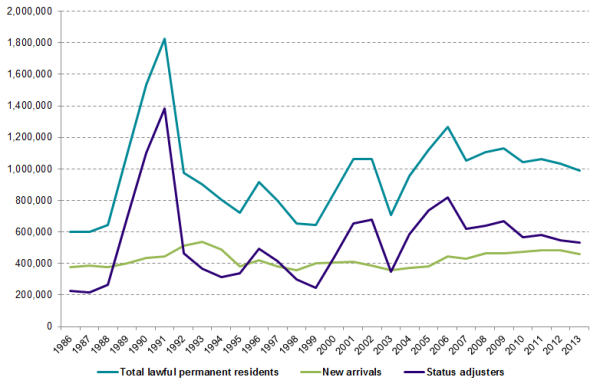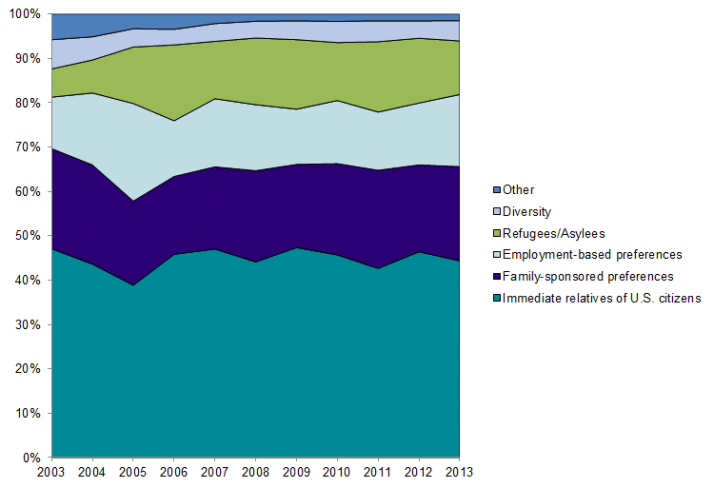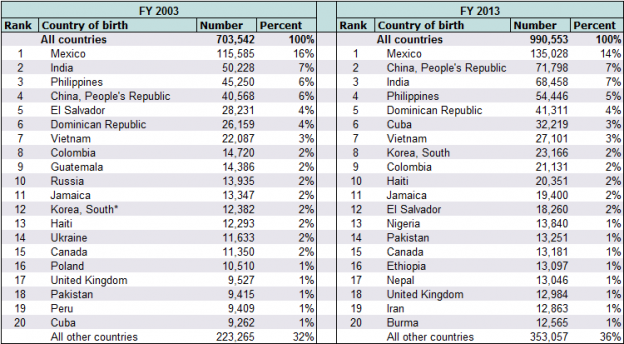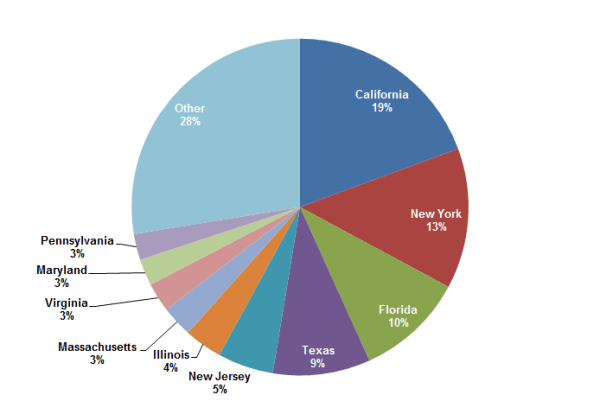You are here
Green-Card Holders and Legal Immigration to the United States

Nearly 1 million people received U.S. green cards in 2013. (Photo: Sarah Sosiak)
Lawful permanent residents (LPRs), also known as green-card holders, are persons lawfully admitted for permanent residence in the United States who have the right to reside, work, study, and own property in the country. They may serve in the U.S. military and apply to become U.S. citizens once they meet eligibility requirements. Close to 1 million people received green cards in 2013, a 4 percent drop from 1.03 million in 2012.
The annual inflow of LPRs has ebbed and flowed with changes in U.S. immigration policy and processing backlogs. There are four main pathways to gain LPR status: family sponsorship, a job offer from a U.S. employer, humanitarian reasons, and selection via a green-card lottery. The immigrant-admission system prioritizes family-based immigrants, followed by employer-sponsored immigrants and those who arrive as humanitarian migrants. A total of 55,000 green cards are reserved for the lottery, known as the Diversity Visa program. Click here for an interactive chart showing the annual number of new LPRs between 1820 and 2013.
Using data from the Department of Homeland Security’s (DHS) Yearbook of Immigration Statistics, this Spotlight provides information on foreign nationals who were granted LPR status during fiscal year (FY) 2013, focusing on the type and broad class of admission, major countries of origin, and geographic distribution within the United States.
Note: All yearly data is for the government's fiscal year (October 1 through September 30). All data are from the DHS Office of Immigration Statistics (OIS) unless otherwise noted.
Click on the bullet points below for more information:
- Recent Arrivals and Status Adjusters
- Broad Class of Admission
- Country of Birth
- State of Residence
- Naturalization Eligibility
Recent Arrivals and Status Adjusters
The total annual number of foreigners who receive LPR status consists of two different flows. The first is newly arrived LPRs—people issued immigrant visas overseas by the State Department. The second is status adjusters—individuals who previously entered the United States and then adjusted to permanent residence status from within the country.
A person, for example, might arrive in the United States on an H-1B temporary worker visa. If her company chooses to sponsor her for permanent residence, the employer can petition U.S. Citizenship and Immigration Services (USCIS) for a green card on her behalf under an employment-preference visa. If she meets the criteria and if annual numerical ceilings for employment-preference visas and per-country limits have not been met, she would receive a card stating she is lawfully admitted for permanent residence. She would then be counted as a status adjuster for that year.
Although the number of adjustments has varied between 1986 and 2013, the number of new arrivals has remained relatively stable, with about 420,000 on average per year (see Figure 1). Changes in immigration legislation, application and visa processing times, and case backlogs are primarily responsible for wide fluctuations in the numbers.
In 2013, 990,553 people were granted lawful permanent residence. Of those, 459,751 (46 percent) were new arrivals. Status adjusters comprised the remaining 530,802, who had previously arrived in the United States as nonimmigrants (students and temporary workers, for example) and had their green-card applications approved during 2013.
Figure 1. Lawful Permanent Residents, by Type, FY 1986-2013

Source: U.S. Department of Homeland Security (DHS), Yearbook of Immigration Statistics (Washington, DC: DHS Office of Immigration Statistics, various years), available online.
The law provides for four general immigrant categories: family reunification, employment sponsorship, humanitarian cases (refugee and asylum adjustments), and diversity immigrants. The majority of people who wish to obtain a green card qualify as family members of a U.S. citizen or lawful permanent resident, foreigners with needed job skills, refugees or asylum seekers who have been granted protection in the United States, or foreigners from countries with low rates of immigration to the United States (also known as diversity immigrants or green-card lottery immigrants).
Immediate Relatives of U.S. Citizens and Family-Sponsored Preferences
Immigrants who obtained green cards on the basis of a family relationship accounted for 66 percent of the 990,553 new LPRs in 2013. Family-based green-card holders fall into two categories: immediate relatives (spouses, children under the age of 21, and parents of U.S. citizens), who represented 439,460 of new LPRs in 2013; and certain other family members of U.S. citizens and immediate relatives of lawful permanent residents, who accounted for an additional 210,303 new LPRs (see Figure 2). During the last decade, family-based immigration has represented between 60 percent and 70 percent of total lawful permanent immigration.
Figure 2. Lawful Permanent Residents, by Broad Class of Admission, FY 2003-13

Note: The “other” category includes individuals and their dependents legalized under the Immigration Reform and Control Act (IRCA) of 1986, parolees, and children born to LPRs.
Source: DHS, Yearbook of Immigration Statistics, various years.
Employment-Based Preferences
Sixteen percent (161,110) of all LPRs received green cards through employer sponsorship. The share of employment-preference immigrants has varied over the past decade, from a low of 12 percent (81,714) in 2003 and a peak of 22 percent (246,865) in 2005 (see Figure 2).
Similar to past trends, immediate family members of employment-based immigrants accounted for more than half of the employment-preference category in 2013: 53 percent (85,232) of employment-sponsored immigrants were spouses and children of principal applicants.
Refugees and Asylees
Note: These figures refer to those refugees and asylees who adjusted their status to LPR in 2013. They do not refer to the numbers and percentages of refugee admission and asylum status granted in 2013.
In 2013, approximately 12 percent of all LPRs were status adjusters who entered as refugees (77,395) or arrived independently and were later granted asylum (42,235).
The number and percentage of refugees and asylees getting a green card varied significantly between 2003 and 2013, from a low of 6 percent (44,764) in 2003 to a high of 17 percent (216,454) in 2006 (see Figure 2).
Refugees are required to adjust to LPR status after one year of residence in the United States. Asylees are eligible to apply for LPR status after one year in asylum status. Until 2005, there was a limit of 10,000 asylee adjustments per year. The REAL ID Act of 2005 eliminated this numerical limit. The annual number of asylee adjustments since 2005 has averaged around 61,000, almost six times higher than in 2004 (10,217).
Diversity Visa Lottery
Each year the U.S. government grants lawful permanent residence to a select number of applicants worldwide via the Diversity Visa Lottery (DV Lottery)—run by the State Department. In 2013, 45,618 people received LPR status as diversity immigrants, representing 5 percent of all new LPRs.
The Immigration Act of 1990 established the Diversity Immigrant Visa Program to allow entry to immigrants from countries with low rates of immigration to the United States. No more than 55,000 diversity visas are made available each fiscal year. Of the 55,000 visas, 5,000 must be used for applicants under the Nicaraguan and Central America Relief Act (NACARA) of 1997.
Distribution of the remaining 50,000 green cards is divided among six geographic regions—Africa, Asia, Europe, North America, Oceania, and South/Central America and the Caribbean—with no single country receiving more than 7 percent of the available diversity visas in any one year. Nationals of countries with high levels of immigration to the United States are not eligible to participate. For the purposes of the DV-2016 lottery (registration for which began on October 1, 2014 and ended on November 3, 2014), excluded countries were Bangladesh, Brazil, Canada, China (mainland-born, excluding Hong Kong S.A.R., Macau S.A.R., and Taiwan), Colombia, Dominican Republic, Ecuador, El Salvador, Haiti, India, Jamaica, Mexico, Nigeria, Pakistan, Peru, the Philippines, South Korea, United Kingdom (except Northern Ireland) and its dependent territories, and Vietnam.
Lottery winners must provide proof of a high school education or its equivalent, or demonstrate two years of work experience within the past five years in an occupation that requires at least two years of training or experience. They must also pass a medical exam.
Overall interest in the DV lottery is significantly higher than the 50,000 available visas, but each year the number of applications varies depending on which countries are eligible. More than 9.4 million qualified applications were registered for the DV-2014 program (jumping to 14.6 million when including spouses and minor children listed on the applications), according to the most recent country-specific data available. The number of qualified applications increased 18 percent from the DV-2013 program, which had 7.9 million applicants (12.6 million with dependents). This was largely due to significant increases in applications from Uzbekistan, Nigeria, and Iran. These three countries accounted for 64 percent (920,748 applications) of the increase in applications between DV-2013 and DV-2014.
Other Immigrants
Less numerous groups of immigrants, including individuals and their dependents legalized under the Immigration Reform and Control Act (IRCA) of 1986, parolees, and children born to LPRs abroad, are examples of "other” immigrants who are eligible for LPR status (see Figure 2). In 2013, this category accounted for 1.5 percent (14,432) of all LPRs.
Mexico, China, India, the Philippines, and the Dominican Republic were the top five countries of birth of new LPRs in 2013. Together, they accounted for 37 percent of all persons receiving green cards in 2013. Foreign nationals born in the next five countries—Cuba, Vietnam, South Korea, Colombia, and Haiti—comprised another 13 percent. In all, the top 10 countries of birth composed 50 percent of the total (see Table 1).
As in 2003, the top 20 countries of birth in 2013 accounted for about two-thirds of all LPRs (see Table 1). Fourteen of the top 20 countries in 2013 were also on the 2003 list. Guatemala, Russia, Ukraine, Poland, and Peru dropped out of the top 20, while Nigeria, Ethiopia, Nepal, Iran, and Burma joined it.
Table 1. Lawful Permanent Residents by Country of Birth, FY 2003 and 2013

*Data for South Korea prior to fiscal year (FY) 2009 include a small number of cases from North Korea.
Source: DHS, Yearbook of Immigration Statistics, various years.
Mexico and the Dominican Republic were the top countries of birth for new LPRs applying via family-sponsored preference, accounting for 17 percent and 11 percent, respectively, of the green cards granted through this channel. Additionally, Mexican immigrants represented close to 20 percent of new LPRs as immediate relatives of U.S. citizens. In contrast, India (22 percent), China (13 percent), and Korea (9 percent) were the primary origin countries for employment-based preferences; Iran (8 percent), Nepal (7 percent), and Egypt (7 percent) were the top beneficiary origin countries of the DV program; and Cuba (22 percent) was the largest origin country for refugee and asylee adjusters in 2013.
California was the intended state of residence for 19 percent of the nearly 1 million new LPRs in 2013. Other leading states of intended residence included New York (13 percent), Florida (10 percent), Texas (9 percent), and New Jersey (5 percent). The top 10 destinations—which also included Illinois, Massachusetts, Virginia, Maryland, and Pennsylvania—accounted for 72 percent of all intended LPR destinations (see Figure 3).
Figure 3. New Lawful Permanent Residents by State or Territory of Intended Residence, FY 2013

Source: DHS, Yearbook of Immigration Statistics, 2013.
Lawful permanent residents become eligible to apply for U.S. citizenship after meeting residency and other requirements. Most LPRs must be resident in the United States for five years to be eligible for naturalization, while spouses of U.S. citizens are generally subject to a three-year residency requirement.
There were 13.1 million LPRs residing in the United States as of January 1, 2013, of whom 8.8 million were eligible to naturalize, according to the latest available DHS estimates. Between 1980 and 2012, 28.4 million foreign nationals gained LPR status; 41 percent of them (11.7 million) had taken U.S. citizenship by the end of 2012. A further 5 percent (1.4 million) became citizens before reaching 18 years of age, and 13 percent (3.7 million) had died or emigrated. An estimated 4.4 million had not met the residency requirements, leaving 8.8 million eligible to naturalize.
Sources
Baker, Brian and Nancy Rytina. 2014. Estimates of the Legal Permanent Resident Population in the United States: January 2013. Washington, DC: Department of Homeland Security (DHS). Available Online.
DHS, Office of Immigration Statistics. Various years. Yearbook of Immigration Statistics. Washington, DC: DHS, Office of Immigration Statistics. Available Online.
Department of State. N.d. Diversity Visa Program, DV 2013-2015: Number of Entries Received During Each Online Registration Period by Country of Chargeability. Available Online.
Johnson, Jeh C., Secretary, DHS to Léon Rodriguez, Director, U.S. Citizenship and Immigration Services, memorandum, November 20, 2014. Available Online.
Monger, Randall and James Yankay. 2014. U.S. Lawful Permanent Residents: 2013. Washington, DC: DHS. Available Online.


